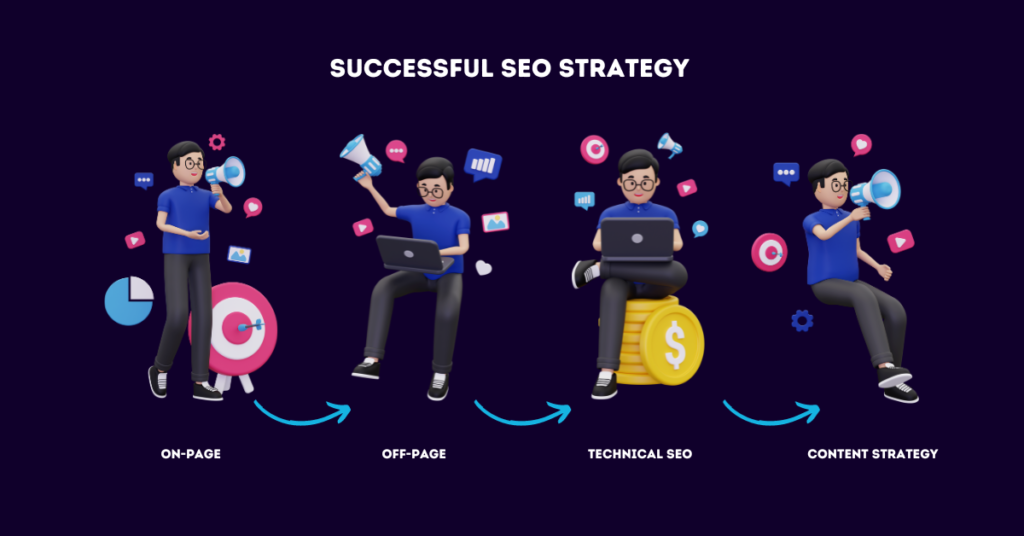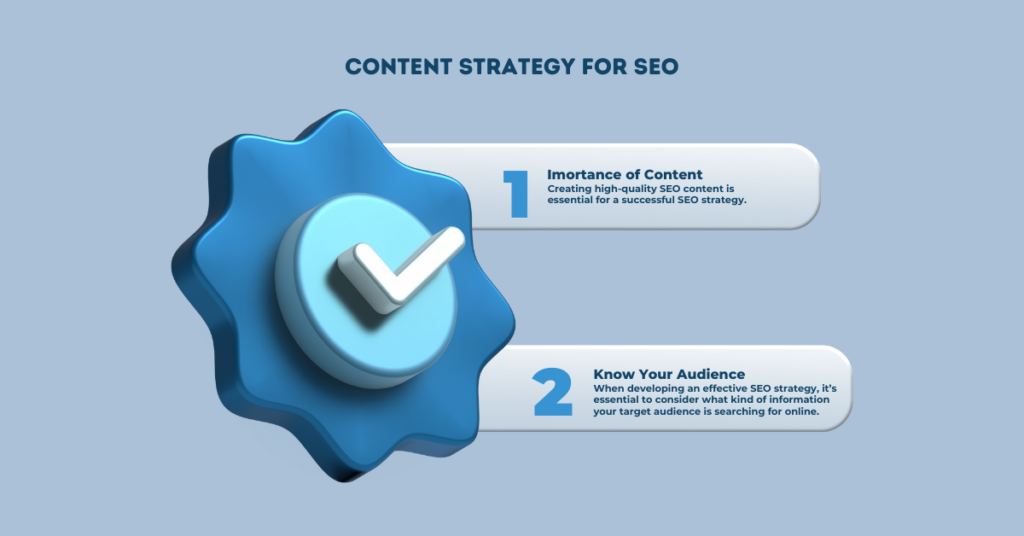SEO Strategy: Crafting an Effective Plan for 2024
Implementing a robust SEO strategy is paramount for enhancing online visibility.
A well-crafted strategy encompasses various vital components that work in tandem to elevate a website’s search engine ranking and drive organic traffic.
Each facet is pivotal in fortifying a practical SEO approach, from keyword research and on-page optimization to link building and content creation.
By understanding the significance of these elements, such as SEO content strategy, businesses can set the stage for successful implementation, ultimately reaping the rewards of heightened digital presence and increased user engagement.
Understand The Basics of SEO Strategy

Definition and Purpose
An SEO strategy involves techniques and tactics to increase a website’s visibility on search engines. Its primary purpose is to drive organic (non-paid) traffic to the site, improving its ranking in search engine results pages (SERPs) with an SEO content strategy.
By optimizing various elements such as content, keywords, and backlinks, an SEO strategy aims to enhance a website’s relevance and authority in the eyes of search engines like Google.
An effective SEO strategy starts with understanding the fundamentals of search engine optimization.
This includes recognizing that search engines use complex algorithms to determine which websites are most relevant to specific queries.
Therefore, businesses must align their strategies with these algorithms by creating high-quality content, utilizing relevant keywords, and acquiring authoritative backlinks.
Fundamentals of Search Engine Optimization
The foundations of an effective SEO strategy lie in understanding how search engines work. Websites that provide valuable information and a positive user experience, tend to rank higher in SERPs.
This means ensuring that webpages load quickly, are mobile-friendly, contain relevant keywords naturally integrated into well-written content, and have descriptive meta tags for each page or post.
Furthermore, businesses must understand that SEO is not about gaming the system but rather about providing value to users while following best practices outlined by search engines themselves. For instance:
- Creating informative blog posts related to your industry and using trusted sources can help establish authority.
- Long-tail keywords specific to your products or services can attract more qualified leads.
- Building relationships with other reputable websites through guest posting or collaboration can improve backlink profiles.
Key Concepts and Principles
Developing an effective SEO strategy also requires grasping key concepts such as keyword research, on-page optimization (including title tags and meta descriptions), and off-page optimization through link-building activities like outreach or partnerships with influencers/other brands within similar niches – all aimed at increasing domain authority which positively impacts rankings over time.
Moreover:
- Regularly updating old content, helps keep it fresh in the eyes of both users and search engine crawlers.
- Leveraging social media platforms for sharing valuable content can further boost visibility.
- Monitoring analytics data regularly provides insights into what works well versus what needs improvement.
The 4 Pillars of a Successful SEO Strategy

On-Page Optimization
On-page optimization involves optimizing individual web pages to rank higher and earn more relevant traffic in search engines.
This pillar focuses on keywords, meta descriptions, title tags, and high-quality content.
By strategically placing keywords within the content, titles, and headings, websites can improve their visibility in search results.
Creating informative meta descriptions helps users understand the page’s content before clicking through.
Successful implementation of on-page optimization includes crafting compelling title tags that incorporate relevant keywords to attract search engines’ and users’ attention.
For example, a bakery website could use “Delicious Homemade Cupcakes | Best Bakery in Town” as a title tag to target local customers searching for baked goods.
Optimizing images with descriptive file names and alt attributes is another essential aspect of on-page optimization that contributes to overall SEO success.
Off-Page Optimization
Off-page optimization refers to activities conducted outside the boundaries of the website to improve its position in search engine rankings.
This pillar mainly revolves around link building – acquiring backlinks from other websites. Backlinks act as votes of confidence for a website’s credibility and relevance.
For instance, a reputable cooking blog linking to a culinary school’s website indicates authority within the industry.
These links demonstrate trustworthiness to search engines by showing that other sites are willing to vouch for the linked site’s quality content or products/services.
Another successful off-page strategy is guest blogging on relevant industry websites or collaborating with influencers who can create valuable backlinks while reaching new audiences.
Technical SEO
Technical SEO ensures that search engine spiders can crawl and index your site without problems.
It involves optimizing your website infrastructure for better usability, speed, mobile-friendliness, security (HTTPS), structured data markup (schema.org), XML sitemaps creation & submission, etc., directly impacting user experience.
Implementing technical strategies like improving site speed by compressing images or leveraging browser caching enhances user experience while positively influencing ranking factors such as bounce rate and time spent on site.
Ensuring mobile responsiveness also plays an essential role in technical SEO since Google prioritizes mobile-friendly sites due to increasing mobile usage trends among internet users globally.
Content Strategy
A robust content strategy, including regularly publishing high-quality articles or blog posts related to your niche area, significantly influences organic traffic growth over time.
Conduct Effective Keyword Research

Importance of Keyword Research
Keyword research is a crucial component of any SEO strategy. It involves identifying the terms and phrases people use to search for information online.
By understanding these keywords, businesses can optimize their website content to match what their target audience is looking for.
This process helps websites rank higher in search engine results pages (SERPs), driving more organic traffic.
Effective keyword research makes it easier for a website to attract exemplary visitors or reach its target audience.
Therefore, incorporating relevant keywords into a website’s content is essential for improving its visibility and attracting quality traffic.
Understanding user intent through keyword research allows businesses to create content that addresses their audience’s needs and interests.
This improves search engine rankings and enhances the overall user experience on the website, leading to higher engagement and conversions.
Tools and Techniques for Conducting Keyword Research
Several tools are available to assist with keyword research, making it easier for businesses to identify relevant keywords and analyze search trends.
These tools provide valuable insights into search volume, competition level, and related keywords that can be used to refine an SEO strategy.
For instance, Google’s Keyword Planner offers data on keyword keyword performance data based on device type.
Another popular tool is SEMrush, which provides com, comprehensive keyword analytics, and competitor analysis features.
When conducting keyword research, techniques such as brainstorming relevant topics related to the business or industry can help generate initial keyword ideas.
Analyzing competitors’ websites can offer insights into which keywords drive traffic to their sites.
By using these tools and techniques effectively, businesses can discover high-potential keywords that align with their goals while gaining an edge over competitors by targeting niche-specific terms.
Utilizing Long-Tail Keywords for Targeted Traffic
Incorporating long-tail keywords into an SEO strategy enables businesses to attract highly targeted traffic by focusing on specific queries rather than broad terms.
Long-tail keywords are longer, more specific phrases than generic short-tail keywords.
For example:
- Short-tail keyword: “digital marketing”
- Long-tail keyword: “best digital marketing strategies for small businesses.”
While short-tail keywords may have high search volumes, they often face intense competition from other websites targeting similar terms.
On the other hand, long-tail keywords typically have lower search volumes but offer higher conversion rates due to their specificity.
Technical SEO and Mobile Optimization

Significance of Technical SEO
SEO strategy is complete with addressing technical aspects. Technical SEO involves optimizing website infrastructure, making it easier for search engines to crawl and index the site.
It ensures that web pages meet search engine requirements for ranking.
Implementing technical SEO improves website speed, user experience, and accessibility. It includes optimizing meta tags, headers, and sitemaps and improving internal linking structures.
These practices enhance a website’s visibility in search results.
Mobile Optimization is Crucial Mobile optimization is vital for modern SEO strategies due to the increasing use of mobile devices for internet browsing.
A mobile-friendly website provides an optimal viewing experience across various devices.
Google prioritizes mobile-friendly websites in its search rankings. Websites not optimized for mobile may experience lower rankings on search engine results pages (SERPs).
So, ensuring a responsive design or separate mobile version of the site is essential.
Best Practices for Implementation
When implementing technical SEO strategies, ensure proper URL structure with relevant keywords instead of random numbers or letters.
Use descriptive file names and alt text on images to improve accessibility and provide context to search engines.
Ensure fast loading times by compressing images and utilizing browser caching techniques.
Use structured data markup such as schema.org to help search engines better understand your content. Create XML sitemaps containing all critical pages on your site to aid crawlers in indexing them efficiently.
Importance of Mobile-Friendly Websites
A significant aspect of any modern SEO strategy revolves around having a mobile-friendly website design.
Responsive web design allows content to adapt seamlessly across different screen sizes without compromising usability or load times.
Ensuring a seamless user experience across desktops, tablets, and smartphones can lead to higher engagement rates and improved conversion metrics.
Implement On-Page SEO Tactics for User Experience

Optimizing Content
SEO strategy involves optimizing content to enhance user experience. This includes using relevant keywords naturally throughout the content.
For instance, if a website owner operates an online shoe store, they should contain keywords like “buy shoes online” or “best place to purchase shoes.”
Creating high-quality and engaging content is crucial for on-page SEO tactics. The website owner must ensure the content effectively addresses their target audience’s needs and queries.
Visitors are more likely to spend time on the site by providing valuable information.
Meta Tags and URL Structures
Meta tags are vital in on-page SEO strategies, providing search engines with information about a web page’s content.
A website owner should focus on creating unique and descriptive meta titles and descriptions for each page, incorporating relevant keywords.
Optimizing URL structures can significantly impact user experience. Clear and concise URLs make it easier for both users and search engines to understand what a page is about.
For example, instead of a messy URL like “www.example.com/p=123,” it’s better to have one like “www.example.com/best-running-shoes.”
Importance of High-Quality Content
High-quality, relevant content is essential for effective on-page SEO as it directly impacts user experience.
When visitors find valuable information that meets their needs, they are likelier to engage with the website by exploring different pages or making purchases.
For instance:
- A blog post sharing tips on choosing the right running shoes can attract potential customers interested in fitness.
- An e-commerce site offering detailed product descriptions and customer reviews enhances trustworthiness while improving search engine rankings.
Build a Strong Backlink Profile and Internal Linking Structure

Impact of Backlinks on SEO
Backlinks play a crucial role in SEO strategy, as they are like “votes” from other websites indicating the quality and relevance of your content.
Search engines view backlinks as signals of trust, authority, and credibility. Websites with high-quality backlinks rank higher in search engine results pages (SERPs).
For instance, if reputable websites link to your content, it sends a positive signal to search engines that your website is valuable.
Acquiring high-quality backlinks involves various strategies, such as creating compelling content that naturally attracts links, reaching out to influencers or industry experts for collaborations or guest posts, submitting press releases or articles to authoritative websites, and participating in relevant online communities or forums where you can share valuable insights and resources.
Leveraging social media platforms can help amplify your content’s visibility and attract organic backlinks.
Importance of Internal Linking
In addition to building a solid external backlink profile, an effective internal linking structure is essential for optimizing website structure and navigation.
Internal links connect different pages within the same domain and help search engines understand the information hierarchy on your website.
By strategically placing internal links throughout your content, you can guide visitors toward important pages while distributing link equity across various sections of your site.
Internal linking also enhances user experience by providing additional relevant information for visitors while keeping them engaged on the website.
For example, when writing a blog post about “10 Best SEO Practices,” you could internally link related articles such as “Understanding Keyword Research” or “Optimizing Meta Tags.”
This helps users discover more valuable content and distributes ranking power across interconnected pages.
How to Develop a Comprehensive Content Strategy for SEO

Role of Content in an Effective SEO Strategy
Creating high-quality SEO content is essential for a successful SEO strategy. When search engines crawl websites, they prioritize valuable and relevant content.
This means that the better the content on a website, the higher it’s likely to rank in search results.
By producing engaging and informative content, websites can attract more visitors and increase their chances of converting them into customers.
Websites with well-crafted SEO content tend to have lower bounce rates because visitors are likelier to stay longer when they find helpful information.
Quality content encourages other websites to link back, which contributes positively to the site’s backlink profile – as discussed in the previous section. For example, suppose a website publishes insightful blog posts about topics related to its industry or niche.
In that case, it establishes itself as an authority and resource hub for users and search engines.
Incorporating keywords naturally into content is crucial for improving its visibility on search engine results pages (SERPs).
By strategically placing relevant keywords throughout web pages or blog posts without overstuffing them, websites can signal their relevance to search engines.
This helps improve organic rankings for those keywords while ensuring the language flows naturally for human readers.
Creating Valuable, Engaging Content for Target Audience
When developing an effective SEO strategy, it’s essential to consider what kind of information your target audience is searching for online.
Understanding their needs allows you to create engaging content that addresses them directly.
For instance, if you run an e-commerce website selling fitness equipment, your target audience might be interested in articles about workout routines or product reviews.
By tailoring your content strategy according to your audience’s interests and pain points, you provide value and increase the likelihood of attracting qualified traffic – people genuinely interested in your offer.
This approach enhances user experience and signals relevancy to search engines by showcasing engagement metrics like time spent on the page or low bounce rates.
Producing diverse types of media, such as videos, infographics, and podcasts alongside written articles, can further enrich user experience while catering to different learning preferences within your target audience.
Align Business Goals with SEO and Measuring Success
Connecting Business Objectives with SEO Goals
Small businesses often strive to increase their market share in the industry. They must align their business objectives with a well-defined SEO strategy to achieve this.
For instance, if a small business aims to expand its customer base by 20% within the next year, its SEO goals should focus on improving website visibility and attracting more organic traffic.
Small businesses can ensure that their SEO efforts directly contribute to achieving their overall business objectives by setting specific search engine rankings and organic traffic growth targets.
Large brands also prioritize this alignment. For example, a major retail chain may aim to enhance online sales by 30% over the next quarter.
In such cases, the brand’s SEO strategy would revolve around optimizing product pages for better visibility in search results and driving targeted traffic to boost online sales.
By integrating these specific SEO goals into its broader business plan, the prominent brand can effectively measure success based on how well its website generates sales through organic search.
Key Performance Indicators (KPIs) for Measuring SEO Success
Measuring the success of an SEO strategy involves tracking various key performance indicators (KPIs).
These KPIs provide valuable insights into the effectiveness of implemented tactics and help businesses gauge their progress toward achieving desired outcomes.
Common KPIs for measuring SEO success include organic search traffic, keyword rankings, click-through rates (CTR), conversion rates from organic traffic, and bounce rates.
For instance:
- Organic Search Traffic: This KPI measures the volume of visitors coming to a website through non-paid (organic) search results.
- Keyword Rankings: Businesses monitor how well their target keywords rank in search engine results pages (SERPs) to indicate improved visibility.
- Click-through Rates: CTR indicates how many users clicked on a website’s link after seeing it in search results.
- Conversion Rates: Tracking conversions from organic traffic helps evaluate how effectively visitors turn into customers or leads.
- Bounce Rates: This metric reflects the percentage of visitors leaving a site without further interacting after viewing only one page.
Tools and Methods for Tracking and Analyzing SEO Performance
Businesses use tools like Google Analytics, SEMrush, Ahrefs, Moz Pro, and more to track and analyze SEO performance.
Stay Updated on the Latest SEO Trends and Best Practices
Importance of Staying Updated
Staying current with SEO strategy is crucial for businesses to maintain online visibility and relevance.
By visiting updated, companies can ensure their websites rank well in search engine results, driving organic traffic and potential customers.
For instance, if a business fails to adapt its SEO strategies to align with the latest search engine algorithm updates, it risks losing its competitive edge and falling behind in search rankings.
This could result in decreased website traffic and missed opportunities for customer engagement.
Keeping up with evolving SEO trends allows businesses to capitalize on new growth opportunities.
For example, companies can tailor their content by understanding the importance of optimizing content for voice search as more people use virtual assistants like Siri or Alexa.
Staying abreast of industry best practices helps companies avoid outdated techniques that may no longer be effective or could even harm their online presence.
Adapting Strategies Businesses can adjust their SEO strategies by leveraging resources such as reputable blogs, industry publications, and social media platforms where experts share insights into the latest SEO developments.
These resources provide valuable information about emerging trends and changes in search algorithms.
Moreover, attending webinars or conferences focused on digital marketing offers an opportunity to gain knowledge from industry leaders directly.
Participating in these events or accessing recorded sessions afterward via websites like YouTube or specialized educational platforms provides access to expert advice on adapting SEO strategies effectively.
Conclusion
An effective SEO strategy requires a comprehensive approach encompassing keyword research, technical optimization, user experience, backlinking, content strategy, and continuous adaptation to industry trends.
Organizations can measure success and stay ahead in the digital landscape by understanding the core pillars of SEO and aligning them with business goals.
Embracing these principles enhances online visibility and fosters credibility and trustworthiness, crucial elements in Google’s E-A-T framework.
As you implement these strategies, remember that SEO is an evolving discipline. Staying informed about the latest trends and best practices is essential for maintaining a competitive edge.
By consistently refining your approach based on performance metrics and industry developments, you can ensure that your SEO strategy remains effective and impactful.
Frequently Asked Questions
What is the importance of crafting an effective SEO strategy?
An effective SEO strategy is crucial for improving online visibility, driving organic traffic, and achieving business goals.
It involves optimizing website content to rank higher in search engine results pages, ultimately increasing brand awareness and attracting potential customers.
How can businesses align their goals with SEO strategies?
Businesses can align their goals with SEO strategies by conducting comprehensive research to understand their target audience’s behavior and preferences.
By identifying relevant keywords, creating high-quality content, and optimizing technical aspects of their websites, they can effectively cater to user needs while achieving business objectives.
Why is it essential for website owners to stay updated on the latest SEO trends and best practices?
Staying updated on the latest SEO trends and best practices is crucial for maintaining a competitive edge in the digital landscape.
With constantly evolving search engine algorithms, businesses must adapt strategies to ensure continued success in driving organic traffic and maintaining strong online visibility.
What are the critical components of a successful backlink profile?
A successful backlink profile comprises high-quality inbound links from authoritative websites within the same industry or niche.
These links should be natural and relevant to the website’s content, contributing positively to its credibility and authority in the eyes of search engines.
How does keyword research contribute to an effective SEO strategy?
Keyword research is vital in understanding user intent and behavior when searching for information online.
Businesses can tailor their content around these terms by identifying relevant keywords with high search volumes but manageable competition levels, enhancing their visibility and relevance for target audiences.






